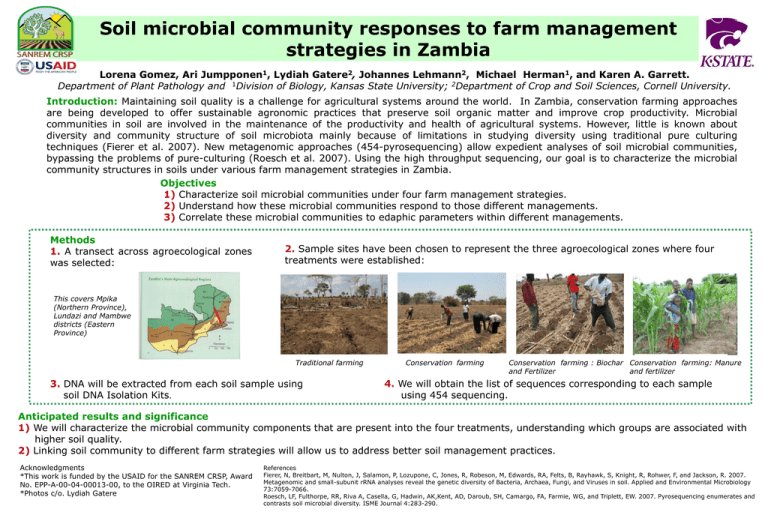Soil microbial community responses to farm management strategies in Zambia
advertisement

Soil microbial community responses to farm management strategies in Zambia Lorena Gomez, Ari Jumpponen1, Lydiah Gatere2, Johannes Lehmann2, Michael Herman1, and Karen A. Garrett. Department of Plant Pathology and 1Division of Biology, Kansas State University; 2Department of Crop and Soil Sciences, Cornell University. Introduction: Maintaining soil quality is a challenge for agricultural systems around the world. In Zambia, conservation farming approaches are being developed to offer sustainable agronomic practices that preserve soil organic matter and improve crop productivity. Microbial communities in soil are involved in the maintenance of the productivity and health of agricultural systems. However, little is known about diversity and community structure of soil microbiota mainly because of limitations in studying diversity using traditional pure culturing techniques (Fierer et al. 2007). New metagenomic approaches (454-pyrosequencing) allow expedient analyses of soil microbial communities, bypassing the problems of pure-culturing (Roesch et al. 2007). Using the high throughput sequencing, our goal is to characterize the microbial community structures in soils under various farm management strategies in Zambia. Objectives 1) Characterize soil microbial communities under four farm management strategies. 2) Understand how these microbial communities respond to those different managements. 3) Correlate these microbial communities to edaphic parameters within different managements. Methods 1. A transect across agroecological zones was selected: 2. Sample sites have been chosen to represent the three agroecological zones where four treatments were established: This covers Mpika (Northern Province), Lundazi and Mambwe districts (Eastern Province) Traditional farming 3. DNA will be extracted from each soil sample using soil DNA Isolation Kits. Conservation farming Conservation farming : Biochar Conservation farming: Manure and Fertilizer and fertilizer 4. We will obtain the list of sequences corresponding to each sample using 454 sequencing. Anticipated results and significance 1) We will characterize the microbial community components that are present into the four treatments, understanding which groups are associated with higher soil quality. 2) Linking soil community to different farm strategies will allow us to address better soil management practices. Acknowledgments *This work is funded by the USAID for the SANREM CRSP, Award No. EPP-A-00-04-00013-00, to the OIRED at Virginia Tech. *Photos c/o. Lydiah Gatere References Fierer, N, Breitbart, M, Nulton, J, Salamon, P, Lozupone, C, Jones, R, Robeson, M, Edwards, RA, Felts, B, Rayhawk, S, Knight, R, Rohwer, F, and Jackson, R. 2007. Metagenomic and small-subunit rRNA analyses reveal the genetic diversity of Bacteria, Archaea, Fungi, and Viruses in soil. Applied and Environmental Microbiology 73:7059-7066. Roesch, LF, Fulthorpe, RR, Riva A, Casella, G, Hadwin, AK,Kent, AD, Daroub, SH, Camargo, FA, Farmie, WG, and Triplett, EW. 2007. Pyrosequencing enumerates and contrasts soil microbial diversity. ISME Journal 4:283-290.




